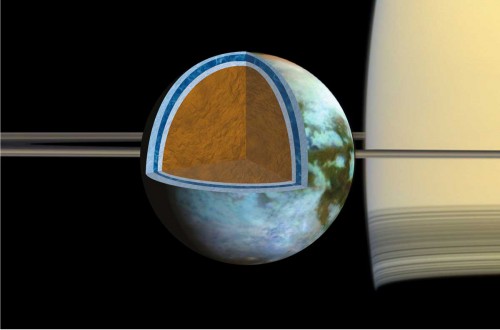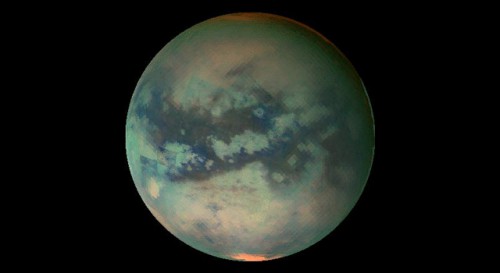
Saturn’s moon Titan is known for its methane seas, lakes, and rivers; surprisingly Earth-like in appearance yet distinctly alien at the same time. But there is also evidence for another ocean, this one of water, below the surface. Little is known about this hidden watery world, but now new results suggest it is likely very salty—as much as the Dead Sea on Earth.
The new results come from the study of data sent back by the Cassini spacecraft, which is still orbiting Saturn. They were published last week in the journal Icarus. Cassini obtained new information about Titan’s interior using gravity and topography data collected during the probe’s many flybys of the moon.
As Linda Spilker, Cassini project scientist at NASA’s Jet Propulsion Laboratory, noted, “Titan continues to prove itself as an endlessly fascinating world, and with our long-lived Cassini spacecraft, we’re unlocking new mysteries as fast as we solve old ones.”
The findings support previous models of Titan’s interior, of a rigid icy shell overlaying the ocean below. In order to explain the gravity data, researchers found that the icy shell must have a high density, most likely explained by very salty, briny water in the ocean. There is a good chance that this ocean is just as salty, if not more so, than the saltiest bodies of water on Earth, including the Dead Sea.
“This is an extremely salty ocean by Earth standards,” according to the paper’s lead author, Giuseppe Mitri of the University of Nantes in France. “Knowing this may change the way we view this ocean as a possible abode for present-day life, but conditions might have been very different there in the past.”

The icy shell may also be in the process of gradually freezing solid, and varies in thickness in different locations. Those differences in thickness are a clue that the icy shell is quite rigid and also that the ocean itself may be slowly crystallizing and turning into ice.
As with other moons with subsurface oceans or seas, such as Europa and Enceladus, the question of habitability and life comes up again, of course. In Titan’s case, if the ocean is gradually freezing into ice, this could limit how much nutrients or other minerals needed would be exchanged between the surface and the water below, a necessary cycle on Earth, which is thought to also likely occur on Europa and possibly Enceladus.
Titan’s atmosphere is rich in methane, and the origin of that methane is still unknown. While a geological source is more likely than a biological one according to planetary scientists, it must be continuously replenished somehow otherwise it would be destroyed by sunlight in a geologically short amount of time. The rigid ice shell would likely indicate that it is being released into the atmosphere from localized “hot spots,” perhaps from volcanic activity.
According to Jonathan Lunine, a scientist on the Cassini mission at Cornell University and a co-author of the new paper: “Our work suggests looking for signs of methane outgassing will be difficult with Cassini, and may require a future mission that can find localized methane sources. As on Mars, this is a challenging task.”
Titan is indeed a challenging world to study, but it is also one of the most fascinating in our Solar System, one which may be similar to Earth early in its history and perhaps even provide clues to how life originated on our own planet.
Want to keep up-to-date with all things space? Be sure to “Like” AmericaSpace on Facebook and follow us on Twitter:@AmericaSpace



